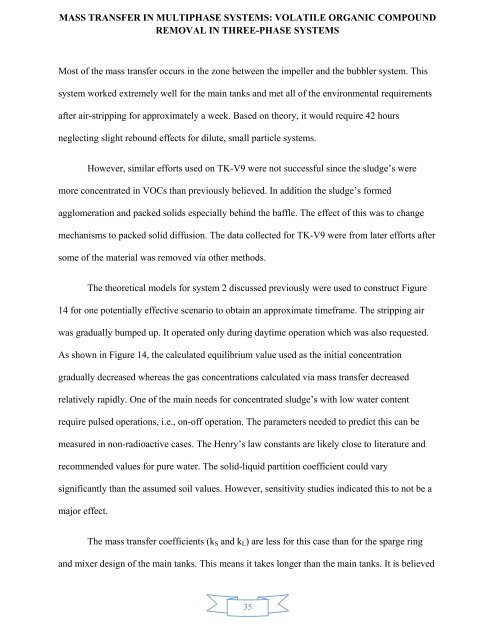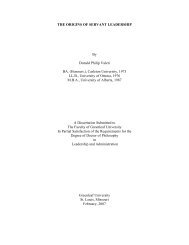mass transfer in multiphase systems - Greenleaf University
mass transfer in multiphase systems - Greenleaf University
mass transfer in multiphase systems - Greenleaf University
Create successful ePaper yourself
Turn your PDF publications into a flip-book with our unique Google optimized e-Paper software.
MASS TRANSFER IN MULTIPHASE SYSTEMS: VOLATILE ORGANIC COMPOUND<br />
REMOVAL IN THREE-PHASE SYSTEMS<br />
Most of the <strong>mass</strong> <strong>transfer</strong> occurs <strong>in</strong> the zone between the impeller and the bubbler system. This<br />
system worked extremely well for the ma<strong>in</strong> tanks and met all of the environmental requirements<br />
after air-stripp<strong>in</strong>g for approximately a week. Based on theory, it would require 42 hours<br />
neglect<strong>in</strong>g slight rebound effects for dilute, small particle <strong>systems</strong>.<br />
However, similar efforts used on TK-V9 were not successful s<strong>in</strong>ce the sludge’s were<br />
more concentrated <strong>in</strong> VOCs than previously believed. In addition the sludge’s formed<br />
agglomeration and packed solids especially beh<strong>in</strong>d the baffle. The effect of this was to change<br />
mechanisms to packed solid diffusion. The data collected for TK-V9 were from later efforts after<br />
some of the material was removed via other methods.<br />
The theoretical models for system 2 discussed previously were used to construct Figure<br />
14 for one potentially effective scenario to obta<strong>in</strong> an approximate timeframe. The stripp<strong>in</strong>g air<br />
was gradually bumped up. It operated only dur<strong>in</strong>g daytime operation which was also requested.<br />
As shown <strong>in</strong> Figure 14, the calculated equilibrium value used as the <strong>in</strong>itial concentration<br />
gradually decreased whereas the gas concentrations calculated via <strong>mass</strong> <strong>transfer</strong> decreased<br />
relatively rapidly. One of the ma<strong>in</strong> needs for concentrated sludge’s with low water content<br />
require pulsed operations, i.e., on-off operation. The parameters needed to predict this can be<br />
measured <strong>in</strong> non-radioactive cases. The Henry’s law constants are likely close to literature and<br />
recommended values for pure water. The solid-liquid partition coefficient could vary<br />
significantly than the assumed soil values. However, sensitivity studies <strong>in</strong>dicated this to not be a<br />
major effect.<br />
The <strong>mass</strong> <strong>transfer</strong> coefficients (k S and k L ) are less for this case than for the sparge r<strong>in</strong>g<br />
and mixer design of the ma<strong>in</strong> tanks. This means it takes longer than the ma<strong>in</strong> tanks. It is believed<br />
35



